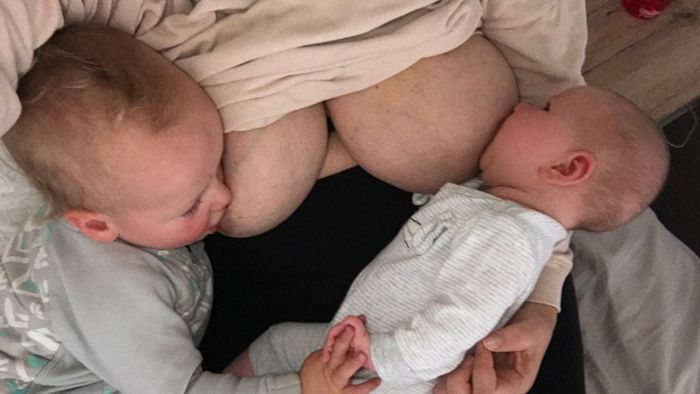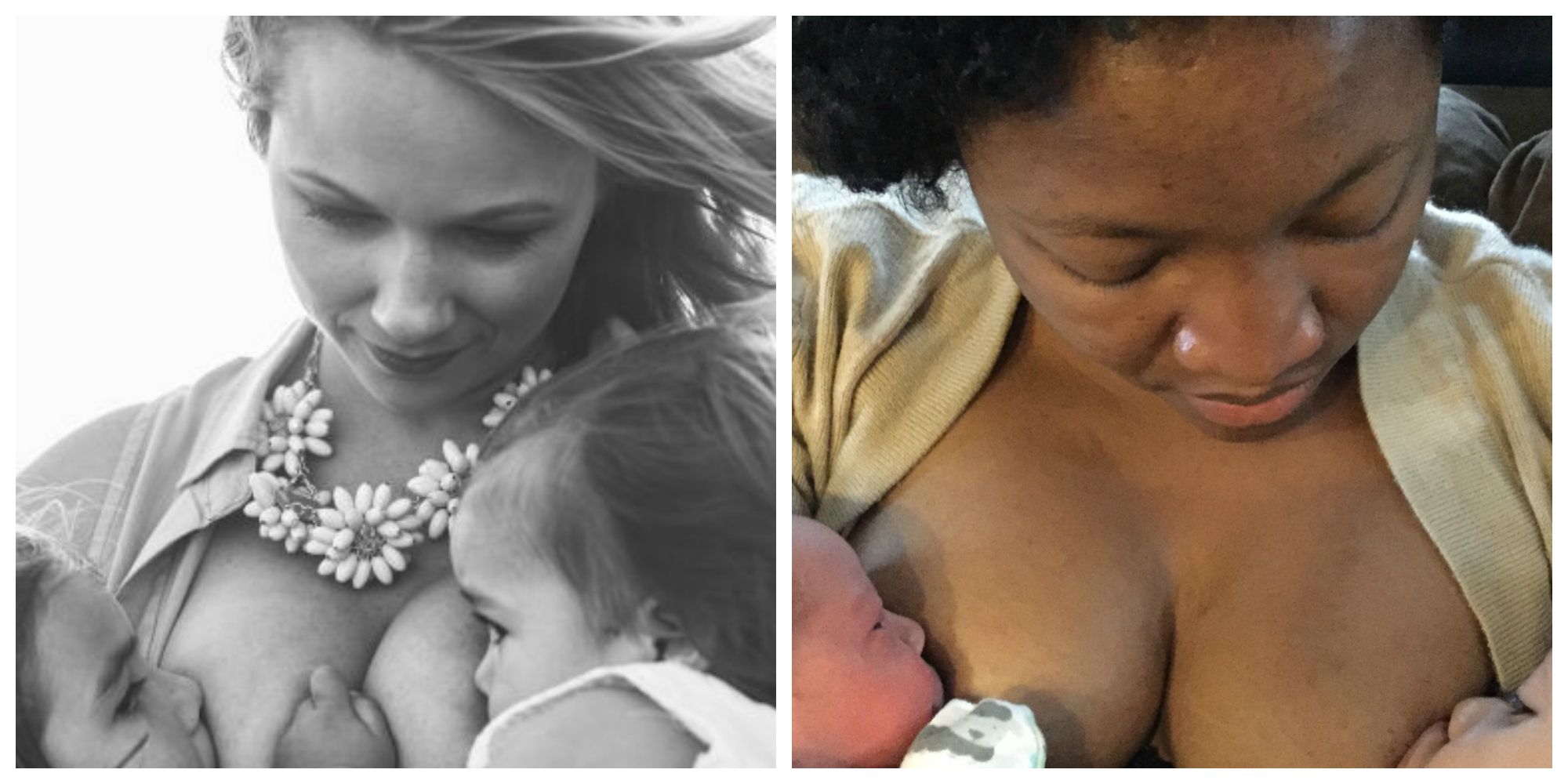Virtually all mothers can breastfeed provided they have accurate information and the support of their family the health care system and society at large. This will change as your baby grows.

What Is Tandem Breastfeeding And Does It Have Any Health Benefits Medela
The American Academy of Pediatrics recommends breastfeeding as the sole source of nutrition for your baby for about 6 months and can be continued for as long as both mother and baby desire it.

Can you breastfeed 2 babies of different ages. The NHS suggest that it can take up to six weeks to successfully establish breastfeeding NHS 2016 NHS 2017. The World Health Organization WHO recommends exclusive breastfeeding for the first 6 months with continued breastfeeding for 2 years or more. Giving your baby formula can affect your milk supply especially when you first start breastfeeding.
Your babys doctor can help you weigh the risks benefits and costs of each option including having a friend or relative breastfeed your baby. Breastfeeding takes time and practice for both mothers and babies. It is important to use whole milk because children under 2 years of age need the extra fat for brain development.
Newborns often want to feed every 2-3. The decision to breastfeed two children after the new baby is born is a personal one. How often you should breastfeed your baby depends on whether your baby prefers small frequent meals or longer feedings.
Read here about what breastfeeding provides at the different ages and stages of your babys life. Which of these is best for your baby depends on your individual situation. 1 The World Health Organization also recommends exclusively breastfeeding up to 6 months with continued breastfeeding along with appropriate.
In different parts of the world the average weaning age is between 2 and 4 years old. It allows the little one to get more of the immune-boosting. Colostrum the yellowish sticky breast milk produced at the end of pregnancy is.
While some may raise an eyebrow if they spy you breastfeeding your toddler theres a lot of official support for extended breastfeeding which is defined as breastfeeding a toddler past age 1. If pregnancy hormones dont disrupt breastfeeding too much breastfeeding can be a special way for you and your older child to stay connected while you contemplate the changes to come. You can breastfeed as many babies as you have and your body will produce milk to meet the demand.
However many mothers need practical support with positioning their baby for breastfeeding and making sure their baby is correctly attached to the breast. In fact both groups advise continued breastfeeding for as long as it is beneficial to both mother and child. There are quite a number of advantages to extended breastfeeding or breastfeeding well past the usual one year and into the toddler years.
Breastfeeding siblings that arent twins is called tandem nursing. If breastfeeding doesnt work for you infant formula can provide your baby with the nutrition she needs. If the mother has had spinal or epidural anaesthesia the baby should be delivered onto her chest and she can start skin-to-skin contact and initiate breastfeeding during the first hour in a similar way to that after vaginal delivery.
If you feed formula your baby will eat about 6 to 8 ounces 180 to 240 milliliters per feeding but should not have more than 32 ounces 950 milliliters in 24 hours. The American Academy of Pediatrics AAP advises that continued breastfeeding has benefits for as long as mom and child want to do it. After 6 months of age it becomes increasingly difficult for breastfed infants to meet their nutrient needs from human milk alone.
The World Health Organization recommends exclusive breastfeeding ie. It means your baby breastfeeds less often so your body produces less milk WHO 2019. This gap is widest in the West and Central Africa region where 63 per cent of babies in the poorest families still receive breastmilk at 2 years compared to only 26 per cent in the richest.
The American Academy of Pediatrics AAP recommends that infants be exclusively breastfed for about the first 6 months with continued breastfeeding while introducing appropriate complementary foods for 1 year or longer. Breastfeeding is the normal way of providing young infants with the nutrients they need for healthy growth and development. In some cultures its perfectly normal to breastfeed well past the first year of life so the idea of breastfeeding a baby past 12 months isnt extended at all.
You can start to introduce solid foods at age 6 months. When you have two children in close succession you may want to continue breastfeeding your toddler even after the new baby arrives. In settings where environmental sanitation is very poor waiting until even later than 6 months to introduce complementary foods might reduce exposure to food.
Of babies are still breastfed at age 2 as recommended by UNICEF and WHO compared to only 41 per cent among the richest families see Figure 3. Mothers and babies delivered by caesarean section can breastfeed normally unless there is some other complication such as illness or abnormality. Some children are breastfed until ages 6 or 7 in other cultures.
Most of your babys calories should still come from breast milk or formula. The following articles help explain how breastfeeding not only provides excellent nutrition but also sets baby up for healthy growth and development. Babies are born with the reflex to look for their mothers breast.
After that the World Health Organization WHO suggests babies should be given nutritious complementary foods and continue breastfeeding. Furthermore most infants are developmentally ready for other foods at about 6 months. At 1 year of age babies can switch to whole cows milk.
Breast milk is not a good source of iron. Since breastfeeding works on supply and demand you should have an adequate milk supply for both children. The World Health Organization WHO similarly recommends exclusive breastfeeding to 6 months followed by appropriate complementary foods with continued breastfeeding to 2 years of age or beyond4 5 Rates of breastfeeding in Australia have increased over the last 50 years although there remains room for improvement.
No other fluids or solids for six months and then continued breastfeeding combined with solid foods for 2 years or as long as mother and baby desire. You might notice that there is no mention of a cutoff or weaning age. However breastfeeding twins is definitely very demanding and you may need practical help in setting up your feeding sessions particularly if you.
1-year-old breastfed babies will benefit from continuing to nurse for as long as.

Multitasking At Its Finest Being Able To Breastfeed Two Babies At Once Makes Her A Real Wond Breastfeeding Photos Breastfeeding Pictures Breastfeeding Images

The Longer Babies Breastfeed The More They Achieve In Life Major Study Breastfeeding The Guardian

How To Breastfeed Two Babies At Once Breastfeeding Twins Breastfeeding Baby Breastfeeding

This Is What Breastfeeding 2 Babies At Once Is Really Like According To 9 Moms

Is It A Nursing Strike How To Tell And How To Deal